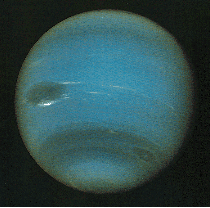General Features of the
Planet Neptune
 Neptune's orbit crosses that of pluto and so sometimes it is
the most distant planet from the Sun, with an orbital radius of 30
Astronomical Units and an orbital period of 165 years.
Its diameter is about four times that
of the Earth, which makes it the 4th largest planet. It is slightly smaller
than Uranus, but its density is 1.6 g/cc (compared with 1.2 g/cc for Uranus),
which makes it the 3rd most massive planet.
The relatively low density indicates large concentrations of hydrogen and
helium, but Uranus and Neptune both have much larger concentrations of heavier
elements than Jupiter and Saturn. As for all the gas giant planets, models
suggest rocky cores of maybe 15 Solar masses, but there is no direct
confirmation of this.
Neptune's orbit crosses that of pluto and so sometimes it is
the most distant planet from the Sun, with an orbital radius of 30
Astronomical Units and an orbital period of 165 years.
Its diameter is about four times that
of the Earth, which makes it the 4th largest planet. It is slightly smaller
than Uranus, but its density is 1.6 g/cc (compared with 1.2 g/cc for Uranus),
which makes it the 3rd most massive planet.
The relatively low density indicates large concentrations of hydrogen and
helium, but Uranus and Neptune both have much larger concentrations of heavier
elements than Jupiter and Saturn. As for all the gas giant planets, models
suggest rocky cores of maybe 15 Solar masses, but there is no direct
confirmation of this.
The bluish color of the adjacent image
is, as for Uranus, because of methane in the atmosphere, which
absorbs red light, leaving the light scattered from Neptune preferentially
enhanced at blue wavelengths. The period of rotation is about 16 hours,
comparable to that of Uranus and much slower than for Jupiter and Saturn. The
temperatures at the cloud tops are about -216 degrees Celsius, slightly warmer
than for Uranus. Neptune, like Jupiter and Saturn but unlike Uranus,
has an internal heat source and produces 2.7 times
more heat than it absorbs.
 Neptune's orbit crosses that of pluto and so sometimes it is
the most distant planet from the Sun, with an orbital radius of 30
Astronomical Units and an orbital period of 165 years.
Its diameter is about four times that
of the Earth, which makes it the 4th largest planet. It is slightly smaller
than Uranus, but its density is 1.6 g/cc (compared with 1.2 g/cc for Uranus),
which makes it the 3rd most massive planet.
The relatively low density indicates large concentrations of hydrogen and
helium, but Uranus and Neptune both have much larger concentrations of heavier
elements than Jupiter and Saturn. As for all the gas giant planets, models
suggest rocky cores of maybe 15 Solar masses, but there is no direct
confirmation of this.
Neptune's orbit crosses that of pluto and so sometimes it is
the most distant planet from the Sun, with an orbital radius of 30
Astronomical Units and an orbital period of 165 years.
Its diameter is about four times that
of the Earth, which makes it the 4th largest planet. It is slightly smaller
than Uranus, but its density is 1.6 g/cc (compared with 1.2 g/cc for Uranus),
which makes it the 3rd most massive planet.
The relatively low density indicates large concentrations of hydrogen and
helium, but Uranus and Neptune both have much larger concentrations of heavier
elements than Jupiter and Saturn. As for all the gas giant planets, models
suggest rocky cores of maybe 15 Solar masses, but there is no direct
confirmation of this.